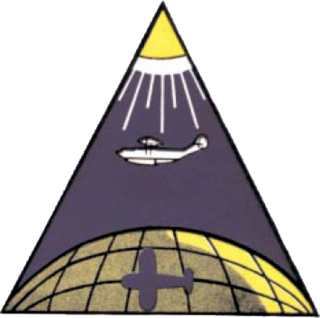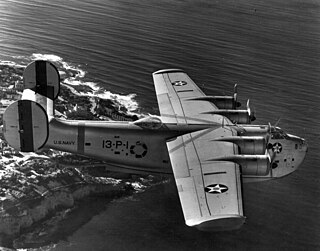
USS Daniel T. Griffin (DE-54/APD-38), a Buckley-class destroyer escort of the United States Navy, was named in honor of Ordnanceman Daniel T. Griffin (1911–1941), who was killed in action during the Japanese attack on the Hawaiian Islands.

USS Whitman (DE-24) was an Evarts-class destroyer escort constructed for the United States Navy during World War II. It was promptly sent off into the Pacific Ocean to protect convoys and other ships from Japanese submarines and fighter aircraft. By the end of the war, when she returned to the United States, she had accumulated four battle stars.

VP-102 was a Patrol Squadron of the U.S. Navy. It was established as VP-18 on 1 September 1937, redesignated as VP-13 on 1 July 1939, redesignated as VP-26 on 11 December 1939, redesignated as VP-102 on 16 December 1940 and disestablished on 18 April 1942.
VPB-91 was a Patrol Bombing Squadron of the U.S. Navy. The squadron was established as Patrol Squadron 91 (VP-91) on 1 December 1941, redesignated as Patrol Bombing Squadron 91 (VPB-91) on 1 October 1944 and disestablished on 2 April 1946.

VPB-23 was a patrol bombing squadron of the U.S. Navy. The squadron was established as Patrol Squadron 10-S (VP-10S) on 1 July 1930, redesignated Patrol Squadron 10-F (VP-10F) on 17 July 1933, redesignated Patrol Squadron 10 (VP-10) on 1 October 1937, redesignated Patrol Squadron 25 (VP-25) on 1 July 1939, redesignated Patrol Squadron 23 (VP-23) on 1 August 1941, redesignated Patrol Bombing Squadron 23 (VPB-23) on 1 October 1944 and disestablished on 25 January 1946.
VPB-24 was a Patrol Bombing Squadron of the U.S. Navy. The squadron was established as Patrol Squadron 9-S (VP-9S) on 7 January 1930, redesignated Patrol Squadron 9-B (VP-9B) on 1 October 1930, redesignated Patrol Squadron 9-F (VP-9F) on 26 October 1931, redesignated Patrol Squadron 9 (VP-9) on 1 October 1937, redesignated Patrol Squadron 12 (VP-12) on 1 July 1939, redesignated Patrol Squadron 24 (VP-24) on 1 August 1941, redesignated Patrol Bombing Squadron 24 (VPB-24) on 1 October 1944 and disestablished on 20 June 1945.
VPB-29 was a Patrol Bombing Squadron of the U.S. Navy. The squadron was established as Pacific Air Detachment on 17 January 1923, redesignated Patrol Squadron 14 (VP-14) on 29 May 1924, redesignated Patrol Squadron 1-Naval District 14 (VP-1D14) on 21 September 1927, redesignated Patrol Squadron 1-B (VP-1B) on 1 July 1931, redesignated Patrol Squadron 1-F (VP-1F) on 15 April 1933, redesignated Patrol Squadron 1 (VP-1) on 1 October 1937, redesignated Patrol Squadron 21 (VP-21) on 1 July 1939, redesignated Patrol Squadron 1 (VP-1) on 30 July 1940, redesignated Patrol Squadron 101 (VP-101) on 3 December 1940, redesignated Patrol Bombing Squadron 29 (VPB-29) on 1 October 1944 and disestablished on 20 June 1945.
VP-20 was a Patrol Squadron of the U.S. Navy. The squadron was established as Patrol Squadron 8-S (VP-8S) from elements of VT-9S on 1 July 1929, redesignated Patrol Squadron 8-F (VP-8F) on 3 April 1933, redesignated Patrol Squadron 8 (VP-8) on 1 October 1937, redesignated Patrol Squadron 24 (VP-24) on 1 July 1939, redesignated Patrol Squadron 12 (VP-12) on 1 August 1941, redesignated Patrol Bombing Squadron 120 (VPB-120) on 1 October 1944, redesignated Patrol Squadron 120 (VP-120) on 15 May 1946, redesignated Heavy Patrol Squadron (Landplane) 10 (VP-HL-10) on 15 November 1946, redesignated Patrol Squadron 20 (VP-20) on 1 September 1948 and disestablished on 31 March 1949. It was the third squadron to be designated VP-20, the first VP-20 was redesignated VP-44 on 1 July 1940 and the second VP-20 was redesignated VPB-20 on 1 October 1944.

VP-21 was a Patrol Squadron of the U.S. Navy. The squadron was established as Patrol Squadron 7-B (VP-7B) on 23 July 1929, redesignated Patrol Squadron 7-F (VP-7F) on 1 July 1931, redesignated Patrol Squadron 7 (VP-7) on 1 October 1937, redesignated Patrol Squadron 11 (VP-11) on 1 July 1939, redesignated Patrol Squadron 21 (VP-21) on 1 February 1941 and disestablished on 18 April 1942, with the squadron assets merged with VP-101. It was the third squadron to be designated VP-21, the first VP-21 was redesignated VP-45 on 1 July 1939 and the second VP-21 was redesignated VP-1 on 30 July 1940.

VP-22 was a Patrol Squadron of the U.S. Navy. The squadron was established as Patrol Squadron 4D-14 (VP-4D14) on 15 September 1928, redesignated Patrol Squadron 4-B (VP-4B) on 21 January 1931, redesignated Patrol Squadron 4-F (VP-4F) on 17 July 1933, redesignated Patrol Squadron 4 (VP-4) on 1 October 1937, redesignated Patrol Squadron 22 (VP-22) on 1 July 1939 and disestablished on 18 April 1942, with the squadron assets merged with VP-101.

VP-29 was a Patrol Squadron of the U.S. Navy. The squadron was established as Patrol Squadron 14-F (VP-14F) on 1 November 1935, redesignated Patrol Squadron 14 (VP-14) on 4 September 1937, redesignated Patrol Squadron 52 (VP-52) on 1 July 1939, redesignated Patrol Squadron 72 (VP-72) on 1 July 1941, redesignated Patrol Bombing Squadron 122 (VPB-122) on 1 October 1944, redesignated Patrol Squadron 122 (VP-122) on 15 May 1946, redesignated Heavy Patrol Squadron (Landplane) 12 (VP-HL-12) on 15 November 1946, redesignated Patrol Squadron 29 (VP-29) on 1 September 1948 and disestablished on 18 January 1950.

VP-33 was a Patrol Squadron of the U.S. Navy. The squadron was established as Patrol Squadron 12-F (VP-12F) on 1 November 1935, redesignated Patrol Squadron 12 (VP-12) on 1 October 1937, redesignated Patrol Squadron 51 (VP-51) on 1 July 1939, redesignated Patrol Squadron 71 (VP-71) on 1 July 1941, redesignated Patrol Bombing Squadron 71 (VPB-71) on 1 October 1944, redesignated Patrol Squadron 71 (VP-71) on 15 May 1946, redesignated Amphibian Patrol Squadron 3 (VP-AM-3) on 15 November 1946, redesignated Patrol Squadron 33 (VP-33) on 1 September 1948 and disestablished on 15 December 1949. It was the third squadron to be designated VP-33; the first had been redesignated from VP-5 on 1 July 1939 and was in turn redesignated as VP-32 on 1 October 1941. The second VP-33 was redesignated VPB-33 on 1 October 1944.
VP-41 was a Patrol Squadron of the U.S. Navy. The squadron was established as Patrol Squadron 21 (VP-21) on 1 March 1944, redesignated Patrol Bombing Squadron 21 (VPB-21) on 1 October 1944, redesignated Patrol Squadron 21 (VP-21) on 15 May 1946, redesignated Medium Patrol Squadron (Seaplane) 11 (VP-MS-11) on 15 November 1946, redesignated Patrol Squadron 41 (VP-41) on 1 September 1948 and disestablished on 23 April 1949.

VPB-11 was a Patrol Bombing Squadron of the U.S. Navy. The squadron was established as Torpedo & Bombing Squadron 19-D14 (VT-19D14) on 7 February 1924, redesignated Torpedo & Bombing Squadron 6D14 (VT-6D14) on 1 July 1927, redesignated Patrol Squadron 6-B (VP-6B) on 1 April 1931, redesignated Patrol Squadron 6-F (VP-6F) on 17 July 1933, redesignated Patrol Squadron 6 (VP-6) on 1 October 1937, redesignated Patrol Squadron 23 (VP-23) on 1 July 1939, redesignated Patrol Squadron 11 (VP-11) on 1 August 1941, redesignated Patrol Bombing Squadron 11 (VPB-11) on 1 October 1944 and disestablished on 20 June 1945.

VPB-13 was a patrol bombing squadron of the U.S. Navy. The squadron was established as Patrol Squadron 13 (VP-13) on 1 July 1940, redesignated Patrol Bombing Squadron 13 (VPB-13) on 1 October 1944 and disestablished on 1 December 1945.
VPB-197 was a Patrol Bombing Squadron of the U.S. Navy. The squadron was established as Patrol Squadron 21 (VP-21) on 1 September 1938, redesignated Patrol Squadron 45 (VP-45) on 1 July 1939, redesignated Patrol Squadron 14 (VP-14) on 1 December 1939, redesignated Patrol Squadron 26 (VP-26) on 15 April 1941, redesignated Patrol Squadron 14 (VP-14) on 1 July 1941, redesignated Patrol Bombing Squadron 14 (VPB-14) on 1 October 1944, redesignated Patrol Bombing Squadron 197 (VPB-197) on 2 December 1944 and disestablished on 1 April 1946.
VPB-34 was a Patrol Bombing Squadron of the U.S. Navy. The squadron was established as Patrol Squadron 34 (VP-34) on 16 April 1942, redesignated Patrol Bombing Squadron 34 (VPB-34) on 1 October 1944 and disestablished on 7 April 1945.

VPB-43 was a Patrol Bombing Squadron of the U.S. Navy. The squadron was established as Patrol Squadron 43 (VP-43) on 21 July 1941, redesignated Patrol Bombing Squadron 43 (VPB-43) on 1 October 1944 and disestablished on 15 September 1945.
VPB-44 was a Patrol Bombing Squadron of the U.S. Navy. The squadron was established as Patrol Squadron 44 (VP-44) on 3 June 1941, redesignated Patrol Bombing Squadron 44 (VPB-44) on 1 October 1944 and disestablished on 20 June 1945.

VPB-52 was a Patrol Bombing Squadron of the U.S. Navy. The squadron was established as Torpedo Squadron 3D15 (VT-3D15) on 12 July 1928, redesignated Patrol Squadron 3-S (VP-3S) on 21 January 1931, redesignated Patrol Squadron 3 Base Force (VP-3F) on 17 July 1933, redesignated Patrol Squadron 3 (VP-3) on 1 October 1937, redesignated Patrol Squadron 32 (VP-32) on 1 July 1939, redesignated Patrol Squadron 52 (VP-52) on 1 July 1941, redesignated Patrol Bombing Squadron 52 (VPB-52) on 1 October 1944 and disestablished on 7 April 1945.












